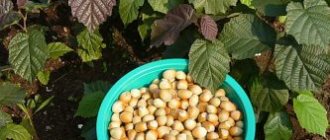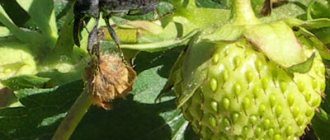Description of technology
The method is used with various abundantly fruiting varieties of berries. Yielding bushes are grown in several stages:
- To obtain seedlings at the beginning of the season, mother bushes are planted in sandy soil. Peduncles are cut off in the first year. The main resources of the plant are directed to reproduction.
- Annual seedlings are grown during the season.
- In late autumn, the bushes enter a state of growth arrest and bud formation, the so-called “resting phase.” This can be understood by the appearance of the plants: the root becomes brown, only the tips remain light, the leaves darken and turn brown. At this point, the seedlings are dug up, cleaned, sorted into classes and sent for storage until the next planting.
- Ready seedlings are planted in open ground at the beginning of the season, usually in May. Year-round planting is possible in greenhouses. If you need continuous harvesting throughout the year, the planting difference is approximately 2-3 weeks.
- Plants that have retained all the nutrients and have not wasted them over the winter fighting unfavorable conditions quickly begin to bear fruit. The berries ripen within 1.5 months after planting.
Frigo strawberry seedlings: freezing, growing
I specially scheduled a meeting with Andrei Kulbitsky from the Kopyl district for the beginning of autumn.
I really wanted to try the September strawberries. Yes, yes, I didn’t make a mistake. It is at this time that the berries, saturated with the autumn warmth, ripen on his plot. For as long as Andrey can remember, he has always been interested in plants. At the age of 12, he was already growing garden cranberries on his own. And this despite the fact that the city dweller is from Minsk. When the parents got a dacha near Radoshkovichi, the first thing they did was ask their son if he would take care of the garden. It must be said that even later, after graduating and receiving a diploma in metallurgy, Andrei still prefers plants to all other hobbies. Here, in the Kopyl region, he has 50 acres - a huge expanse for his own experiments. And, I must say, there are a lot of them. The area is surrounded by flowers - dahlias, chrysanthemums, callas, asters, ornamental shrubs, berries...
But now strawberries dominate here. Despite the fact that the season for this berry is short, Andrey manages to harvest until frost. And all thanks to... the refrigerator. I think many people have heard about frigo seedlings. For those who are not in the know, let me remind you.
frozen lady
The word frigo means “cold” in Latin. In fact, frigo seedlings are annual frozen seedlings with an open root system. Such plants have their obvious advantages over ordinary green seedlings. Seedlings can be planted in the ground at any time - from April to August, which allows you not only to get the harvest on time, but also to avoid spring frosts - very dangerous for flowering strawberries.
Keeping in mind that the first berries appear 8-10 weeks after planting, it is easy to calculate that by planting seedlings in June, the harvest can be harvested in August-September, etc. Andrey does just that: he plants varieties for the autumn harvest in early summer. His priority is remontant varieties - “Portola”, “Albion”, “San Andreas”. But even ordinary early ones bear fruit well in the fall.
And so that the seedlings are always at hand (that is, in the refrigerator), the owner during the season selects rosettes of the so-called “first” stage, trims them and plants them in pots. When they take root properly, they dig them up and store them in the refrigerator, where the temperature is minus 1 - 2 degrees. Andrey converted one of the large industrial refrigerators into a kind of frost nursery, where he stores the plants until planting.
— I’m interested in working with strawberries,
- Kulbitsky admits.
- Yes, this is a rather difficult and painstaking task, but with proper care, the berries will please you with a good harvest.
I started, like everyone else, with the traditional planting of strawberries in open ground, covering the ground under the bushes with straw. But I wanted something more progressive. So I switched to growing bushes on raised beds, mulched with spunbond with drip irrigation and a two-line planting scheme. On the ridge
Andrey has been preparing the bed for planting since the fall. And the closest attention to the soil - whether there are beetles in it. If it detects at least one pest per 1 sq. m, be sure to treat the bed with insecticides. This season, he admits, everything seemed to be fine when planting, but then the plants began to wither. I had to dilute Aktara (4 g per 10 liters of water) and pour it under the root of each.
When digging, for each square meter it adds 10 kg of rotted manure, 30 g of “Potassium salt” and 60 g of “Superphosphate”. At the beginning of June, the soil is loosened once again, drip irrigation is laid, agrofibre is stretched and seedlings are planted in the “windows” cut out in it. The most difficult thing when growing strawberries is weeding. And here spunbond comes to the rescue.
According to Andrey, such a landing has a number of advantages. Firstly, thanks to the convex shape of the ridge, during rain, water flows away without lingering on it. Secondly, the phytosanitary condition of plants in general and the quality of berries in particular improves. It is easier to harvest and the quality of work is controlled. Thirdly, the soil warms up faster and better. The black color of the spunbond also helps with this. Thanks to it, caring for strawberries is also easier: the soil stays moist longer, and the weeds die. And the harvest itself ripens five days earlier.
But you need to be more careful with the film. If the polyethylene does not fit tightly, an air pocket will form and the soil will warm up unevenly. In winter, it will quickly freeze.
Andrey plants the bushes, carefully ensuring that the roots enter the prepared hole strictly vertically and do not become crushed or bent. The larger the seedlings, the higher the ridge. At least 15 - 20 cm tall.
The soil should be moist during planting, and watering after is mandatory - especially in the first month. It would also be a good idea to immerse the seedlings in water for 10 minutes before planting. Strawberries need to be watered all season long. And not only during flowering and ripening of fruits, but also after picking berries. In August-September, flower buds are laid - the next year's harvest. And yet, Andrei emphasizes, it is imperative to water the berry garden with warm water. For this purpose, cubic containers in which water is heated are placed throughout the area.
Watering with cold water is a kind of stress for the culture. Hence the diseases. And a weakened plant, as you know, is easy prey for pests.
Drip irrigation allows you to control soil moisture, while water consumption is significantly lower compared to conventional sprinkling.
Friendly growth
The seedlings grow quickly and amicably. Within a few days after planting, the first leaves appear. And a month later, Andrey fertilizes the beds, adding the universal complex mineral fertilizer “Lifdrip” (analogous to “Kristalon”). Then another 2 - 3 feedings at intervals of 2 - 3 weeks. He also uses organic matter, since he has his own poultry house. Water the bushes with an infusion of both chicken droppings (1:20) and manure (1:10). At the beginning of the growing season, and then after flowering. With such support, not only the plant itself becomes healthier, as they say, before our eyes, but the berries (surprisingly) also become sweeter. And the yield increases significantly.
In the first year, when planted in summer, strawberries bear fruit in the fall, and in subsequent seasons - as usual. Andrey once calculated that remontant varieties are capable of producing up to 5 (!) harvests per season. After all, they bloom and bear fruit continuously - until frost. But in order not to weaken the harvest, he always breaks off the flower stalks of the first wave of flowering. In addition, at this time there are enough berries and ordinary early varieties. Next year, frigo seedlings will already bloom in their usual rhythm. In one place, Kulbitsky grows remontant varieties for 2 years, and ordinary ones for 3 years, then he uproots the plantings.
Country Frigo
If all your varieties are beardless and there is nothing to prepare frigo from, then at the end of October - beginning of November with the first frosts, when the bushes stop growing and begin to prepare for winter sleep, you can dig up several annual strawberry seedlings. Immediately cut off the leaves and, having packed the plants in plastic bags, store them in the refrigerator, where the conditions are approximately the same as under which the strawberries “fell asleep.” Frozen (if there is no temperature difference), seedlings can be stored for up to three years. The biorhythms of plants are not disturbed.
Frigo takes root almost 100%: the roots are well developed, and the above-ground part is cut off. If the strawberries overwintered in the garden, they could freeze and die. And here, in the refrigerator, is just a winter resort for her. In addition, being in a frozen state, the berry grower does not waste energy trying to adapt to constantly changing temperatures. Therefore, after planting, all forces will be devoted to fruiting.
A matter of taste
Andrey’s approach to the choice of varieties is very simple - whatever pleases with the harvest remains the same. Although he has compared it more than once: the same variety behaves differently in him and his neighbor. In total, there are more than 20 varieties on the site - from ultra-early to the latest. This kind of rotation allows us to select the most suitable ones for local conditions. Andrey himself loves sweet and juicy berries, but his wife, on the contrary, prefers dense ones with a slight sourness.
Of the late varieties, Andrey considers “San Andreas” and “Portola” to be the most delicious. After painting, “Albion” must lie in the garden for a couple of days to gain sugar.
Among all the varieties of different ripening periods, the palm in taste has been awarded to the ancient (bred in the 30s of the last century) late German variety “Mitze Schindler” at the family council for many years now. Its berries are very sweet and aromatic, tasting like both strawberries and raspberries. Therefore, it is not surprising that it is sometimes called “raspberry strawberry”. Plus, “Mitze Schindler” has excellent drought and frost resistance. The variety is also undemanding to growing conditions (it grows well in almost any soil) and is resistant to major crop diseases. It is easy to distinguish it from others by its medium-sized, smooth leaf, the upper part of which is dark green, leathery, with a slight sheen, and the lower part is silvery. For some characteristics, the old “German”, of course, loses to modern varieties. But it has a taste unattainable for them.
Flower expanse
As for flowers, dahlias were the first to appear on the site 5 years ago. And now there are more than 40 varieties. No less impressive (more than 60 varieties) collection of chrysanthemums. And as a keen amateur, Andrey updates them every year with fashionable new items. I noticed that the longer dahlias are in the soil, the better they are stored.
Kulbitsky also has an extensive collection of beautiful and completely unpretentious calla lilies: their bulb is stored much better than gladiolus. For more than 20 years, Andrey has been forcing crocuses and hyacinths. The easiest way to get crocuses to bloom at the right time. To do this, at the end of summer (it’s not too late even now), dig up the bulbs from the garden bed, transplant them into pots with soil, cover them with cellophane and place them in the basement or in the vegetable compartment of the refrigerator. A week before the desired date, bring it into a cool room. In warm weather they will bloom very quickly. The approach to hyacinths is the same, only they bloom in three weeks. The most difficult thing is with tulips: each variety and type has its own temperature and its own forcing pattern.
Looking around the area, among the autumn riot of colors, you can see small “islands” of raspberries, blackberries and cranberries, a growing young garden, flowering water lilies in the pond, a cuttings greenhouse... The main thing is that all this splendor brings real pleasure to Andrey.
Seedling storage
All shoots and large leaves are removed from plants. Shake off the soil from the roots. Treatment with fungicides will prevent fungal diseases. The seedlings are distributed in bunches, depending on the class, packed in thin plastic bags, and placed in refrigerators. The thickness of the packaging polyethylene should be no more than 0.5 mm, otherwise it will not be able to breathe and will die.
It is forbidden to wash or cut the roots, as rotting may begin! Can be stored frozen for a long time.
Interesting! Compliance with storage standards allows you to keep the bushes frozen without loss of yield for 1 year, with a slight decrease in the number of harvested berries - up to 3 years.
The temperature regime should be strictly observed, from 0 to -2 degrees, air humidity – high, 85-90%. When the temperature rises, the seedlings will awaken prematurely, when the temperature drops, they will freeze, and when the humidity decreases, they will wither.
Tips for choosing soil for strawberries
This planting method requires soil with special nutritional value. Soil preparation must begin in the fall. The calculation of soil composition is taken at the rate of 1 m2. You will need to add 11 kg of rotted manure and 30 grams of potassium salt. You will also need superphosphate in the amount of 65 g. It is better to plant the berries in fairly high ridges in 2 rows. Then mulch with straw.
Having understood the Frigo strawberry and what it is, you can consider the advantages and disadvantages of the variety. There is a high yield and the possibility of obtaining it out of season. Gardeners also note the quality and safety of planting material with this method. The disadvantage of this variety is that the seedlings are more expensive than the ordinary type of strawberries. The fruit rate of strawberries is high only in the first year, and then it does not differ from other varieties with an increased cost of the main seedlings.
This material will help you learn how to properly plant strawberries using Frigo technology.
Classification
It is divided into 4 main categories according to the diameter of the section of the root neck of the process. Belonging to a certain class affects the yield and cost of seedlings.
- The class of plants has the thinnest neck, 0.8 to 1.2 cm thick and 1 peduncle. This is the class of the weakest plants; the first year after planting they do not bear fruit; the peduncle is regularly removed so that the bush gains strength over the season.
- Class A crops have a neck with a thickness of 1.2 to 1.5 cm; they form a maximum of 2 peduncles. It begins to bear fruit, with proper care, already in the first year after planting, but produces no more than 20 berries per bush.
- A+ class unites plants with a neck diameter of 1.5 to 1.8 cm, having 3 peduncles, bearing fruit in the year of planting, bearing 25-35 berries per bush.
- WB class is a prestigious seedling with extremely high productivity, the diameter of the root collar is higher than 2.2 cm, the number of peduncles reaches 5, 50 strawberries can be collected from one bush per year of planting. To obtain such seedlings, the rosettes that have given roots are grown in the beds, additionally feeding them.
Landing dates
Let's talk a little more about planting dates, since this issue interests many gardeners. We have already mentioned that berries from such strawberries can be obtained all year round, or at a time convenient for you. To do this, you just need to calculate the number of days until full ripening.
If you plant seedlings in mid-May, then after thirty days flowering will occur, and after another month, fruiting will begin. Planting delayed by two weeks reduces the time until fruiting. However, it is better not to delay planting too much: the weather during this period is not yet very hot, which allows the seedlings to take root better. Delays in planting have a negative impact on class A+ seedlings. Considering that these seedlings have the greatest potential, it is better to plant them earlier.
Class A seedlings have the longest shelf life, which can be planted without much risk until mid-June. Planting at a later date is fraught with a sharp drop in yield, the peak of which occurs at the very end of August - beginning of September. At this time, the nights become cool, which leads to a decrease in the quality of the berries: their taste deteriorates due to the weak accumulation of sugars, they become smaller, softer and the risk of rot increases.
Preparation
The process of preparing for landing is a little unusual. The plant undergoes certain operations and requires a careful approach.
Soils
- Areas in the shade, lowlands with high humidity and slopes with low humidity are not suitable for planting strawberries. Choose sunny flat areas.
- The soil of the seedlings must be nutritious. The site is fertilized with a mixture of 10 kg of manure, 30 g of potassium salt, 60 g of superphosphate per square meter of soil.
- Weed, completely destroying weeds.
- The soil is well moistened.
Seedlings and photos
- Before planting, seedlings must be awakened. To do this, keep it in a closed package at room temperature for 24 hours. A sudden change in temperature will cause heatstroke.
- After defrosting, the rhizomes are trimmed, leaving a length of 10-12 cm, and placed in water to absorb moisture lost during storage.
- After soaking properly, the seedlings are immediately planted in the prepared area.
Planting process
The seedlings are bunches of brown roots and a rosette with leaf buds. The roots are properly straightened and lowered into holes prepared in advance. They should be distributed freely in the soil, not in a bunch, without creases. The distance between seedlings is 30 cm. After planting, the soil around the bush should be compacted so that there are no voids left at the roots. Seedlings need to be watered abundantly.
Attention! When planting, monitor the level of the root rosette: if you cover it with soil, the roots will get wet when watering; If you leave it in the air, the roots will dry out!
Strawberries can be planted on high ridges; this is especially important if the site is in a lowland or close to the groundwater surface. You can form strip or double-sided beds.
How to plant
In order for frigo strawberries to take root safely after long-term cooling and produce an excellent harvest, the soil in the garden bed must be prepared in advance in the fall. The area is dug up and organic fertilizers are applied:
- rotted manure - 10 kg per 1m2;
- potassium salt - 30 g per 1 m2;
- superphosphate - 6 g per 1m2.
In addition, green manure is sometimes planted, which loosens the soil and nourishes it after mowing. The best option for soil poor in humus and organic matter.
Frigo strawberries are usually planted in late spring or early summer. More specific dates largely depend on the weather conditions of the area. After 2 months, a second planting is carried out: a similar stepwise approach ensures an almost continuous harvest.
Algorithm of actions
- The seedlings are removed from the cold room and their awakening begins.
- The polyethylene is opened and the strawberry bushes are doused with warm water. When performing this work, it is important to avoid sudden temperature changes.
- After complete defrosting, the bush is placed in chilled water for several hours in order to replenish the moisture deficiency. Add a little growth stimulant to the water - Zircon, Epina.
- Before planting, the roots of the bushes are cut off.
- Seedlings are planted in the ground at a distance of 15-20 cm from each other. If space allows, it is recommended to leave 30 cm.
- The roots of the plants in the holes are straightened, the rosette is not buried.
- After planting, the bushes are watered and the bed is mulched. It is convenient to use black film with slots as mulch.
- Over the next 10 days after planting, strawberries are irrigated daily. Then watering is done once every 5 days if there has been no rain.
Important: within 15 minutes after the strawberry bushes have been pulled out of the water, they must be rooted. You can’t hesitate, do the work quickly.
Adviсe
- the beds are made in the direction of the southwest;
- the surface of the strawberry field should be either straight or with a slight slope;
- It is better to plant in the evening or in cloudy weather;
- Before placing the seedlings in the holes, the bed is well watered.
You can learn more about the unique method from the video:
Watering
It happens according to the following scheme:
- for the first 10 days every day, then once a week is enough. Amount of water required: 8-10 liters per square meter of soil;
- during flowering, the interval increases to 10 days;
- during fruiting, watering occurs after each berry picking;
- canceled during rain.
The bushes should be watered at the root, avoiding water getting on the leaves and flowers.
Rules for planting strawberries
When the planting season has started, you can plant the Frigo variety in the beds. If the season has not yet arrived, strawberries can also be planted in greenhouse conditions. Frigo is also suitable for planting in flowerpots. If planting takes place in urban conditions, then you can use large pots with a diameter of up to 500 ml. After the summer season begins, you can plant the berries in a permanent place.
Before planting, the roots of Frigo strawberries must be trimmed by about 20 cm. Next, they must be straightened and lowered into the ground so that the root system is distributed evenly over the soil. After the planting process, the soil around the strawberries should be compacted. It is highly undesirable to completely cover the outlet with soil.
Care and feeding
Strawberries quickly take root, growth begins, and after a few days leaves appear.
- It is necessary to regularly loosen the soil and remove emerging weeds.
- Mulching with straw, hay, sawdust is possible.
- It should be fed with complex fertilizers. The first time this is done a month after planting during or immediately after rain. Feeding is possible throughout the entire flowering period.
- It is necessary to monitor the level of nitrogen in the soil to prevent plant diseases. If there is an oversaturation of nitrogen, strawberries may die.
Peculiarity! If you grow strawberries for seedlings, remove all emerging flower stalks; if your goal is to quickly harvest a mature harvest, you need to remove all the whiskers. One bush cannot produce both high-quality seedlings and a tasty harvest!
Protection from diseases and pests
If agrotechnical recommendations are violated, strawberries may suffer from various diseases:
- Gray rot is a fungal infection that is accompanied by the appearance of brown spots on the fruit. To prevent the spread of the disease, affected berries should be destroyed. Copper oxychloride will help cope with the disease.
- Brown, brown or white spotting - with this disease, the leaves are covered with spots of the corresponding shade. Copper oxychloride helps to cope with pathology.
- Powdery mildew - this fungal infection leads to damage to all above-ground plant fragments. In this case, the damaged parts become covered with a white coating and begin to rot. Sulfarid helps to cope with pathology.
Strawberries may also suffer from pest attacks. It is susceptible to attacks by slugs, centipedes and snails.
If the bushes are seriously damaged, you should use Metaldehyde. It is placed on the surface of the soil after harvesting the fruits. It is best to carry out the procedure at the end of September.
Reviews from gardeners
Gardeners and farm owners who plant frigo strawberries note its pros and cons.
The advantages of the technology include:
- the ability to harvest crops all year round, even out of season;
- rapid ripening of fruits after planting;
- ability to resist diseases;
- high yields of high-class seedlings;
- young plants take root well and quickly.
Among the disadvantages are noted:
- high price of seedlings;
- difficulty in creating conditions for storing seedlings, the need for a certain regime, the use of expensive equipment;
- Early fruiting of strawberries grown using this method is possible only in the first year after planting, after which the strawberries become ordinary.
Frigo is a unique technology, which is currently mostly mastered by large farms for growing strawberry crops for sale. But the positive aspects of using technology are gradually introducing it into small gardening for personal use.
Pros and cons of the Frigo technique
Frigo strawberries have a number of advantages and disadvantages. The undeniable advantages include:
- Possibility of continuous cultivation of strawberries;
- Compactness of planting material, which is important during transportation and storage;
- High level of seedling survival rate;
- Increased strawberry productivity.
The method of growing Frigo strawberries also has disadvantages:
- High cost;
- The need for special expensive equipment for storing seedlings;
- Difficulties in growing seedlings in regions with short summers.











